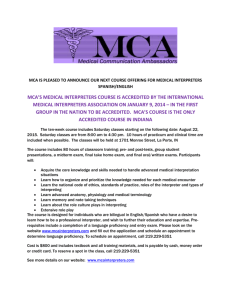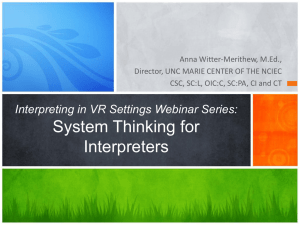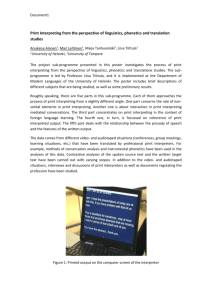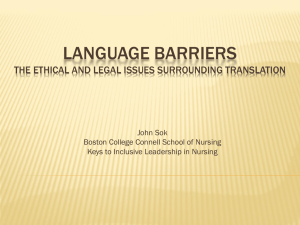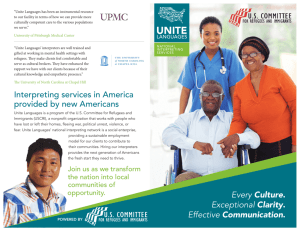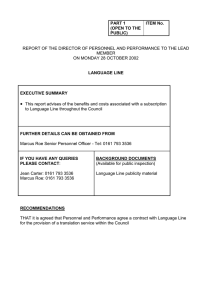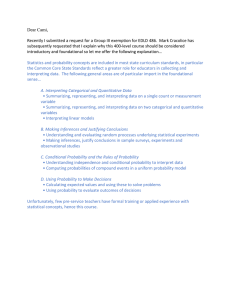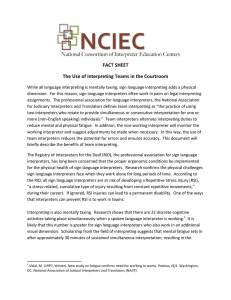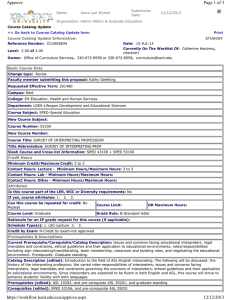0 Is this the first time this course has been offered?
advertisement
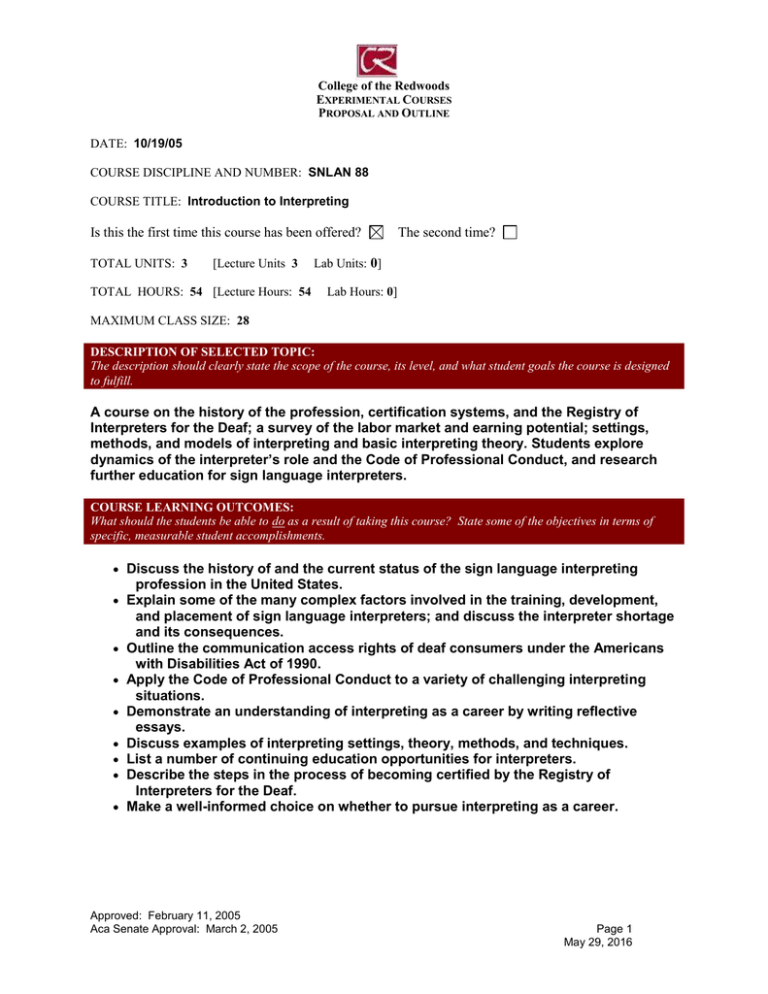
College of the Redwoods EXPERIMENTAL COURSES PROPOSAL AND OUTLINE DATE: 10/19/05 COURSE DISCIPLINE AND NUMBER: SNLAN 88 COURSE TITLE: Introduction to Interpreting Is this the first time this course has been offered? TOTAL UNITS: 3 [Lecture Units 3 TOTAL HOURS: 54 [Lecture Hours: 54 The second time? Lab Units: 0] Lab Hours: 0] MAXIMUM CLASS SIZE: 28 DESCRIPTION OF SELECTED TOPIC: The description should clearly state the scope of the course, its level, and what student goals the course is designed to fulfill. A course on the history of the profession, certification systems, and the Registry of Interpreters for the Deaf; a survey of the labor market and earning potential; settings, methods, and models of interpreting and basic interpreting theory. Students explore dynamics of the interpreter’s role and the Code of Professional Conduct, and research further education for sign language interpreters. COURSE LEARNING OUTCOMES: What should the students be able to do as a result of taking this course? State some of the objectives in terms of specific, measurable student accomplishments. Discuss the history of and the current status of the sign language interpreting profession in the United States. Explain some of the many complex factors involved in the training, development, and placement of sign language interpreters; and discuss the interpreter shortage and its consequences. Outline the communication access rights of deaf consumers under the Americans with Disabilities Act of 1990. Apply the Code of Professional Conduct to a variety of challenging interpreting situations. Demonstrate an understanding of interpreting as a career by writing reflective essays. Discuss examples of interpreting settings, theory, methods, and techniques. List a number of continuing education opportunities for interpreters. Describe the steps in the process of becoming certified by the Registry of Interpreters for the Deaf. Make a well-informed choice on whether to pursue interpreting as a career. Approved: February 11, 2005 Aca Senate Approval: March 2, 2005 Page 1 May 29, 2016 COURSE CONTENT: Attach a copy of the course syllabus (including description, policies, and schedule of instruction and assignments). See attached course syllabus. REPRESENTATIVE LEARNING ACTIVITIES: What will the students be doing (i.e. listening to lectures, participating in discussions and/or group activities, attending a field trip, etc.)? Relate the activities directly to the Course Learning Outcomes. Listening to lectures. Viewing videos. Participating in discussions and role-play activities. Discussing reading assignments in small groups. ASSESSMENT TASKS: How will the students show evidence of achieving the Course Learning Outcomes? Participation in class discussions. Five reflective writing assignments of two to three pages each. One presentation; five to ten minutes in length. One midterm and one final exam, each consisting of a combination of multiple choice and short-answer questions. PREREQUISITES: No Yes Course: SNLAN 4A Rationale for Prerequisite? Describe representative skills without which the student would be highly unlikely to succeed. Students should be at conversational level in American Sign Language and should be fluent in English. The course will include college-level reading, writing, and speaking. COREQUISITE: No Yes Rationale for Corequisite? Course: RECOMMENDED PREPARATION: No Yes Course: SNLAN 4B Rationale for Recommended Preparation? Students should be at conversational level in American Sign Language, and should be fluent in English. The course will include college-level reading, writing, and speaking. EXAMPLES OF APPROPRIATE TEXTS OR OTHER READINGS: Title, Author, and Date are required. Author Humphrey & Alcorn Title So You Want to Be an Interpreter Date 2001 (3rd Ed.) Author Cartwright, Brenda E. Title Encounters with Reality: 1,001 Interpreter Scenarios Date 1999 Author Frishberg, Nancy Title Interpreting: An Introduction Date 1990 Author Mindess, Anna Title Reading Between the Signs: Intercultural Communication for Sign Language Interpreters Date 1999 Other Appropriate Readings: Approved: February 11, 2005 Academic Senate Approved: March 2, 2005 Page 2 May 29, 2016 Submitted by: Ana Maria Romo de Mease; Jane Bloomfield_ Submitting Division/Center Review Ryan Petersen Tel. Ext.4324 Date: 11/21/05 Date: 11/21/05 CURRICULUM COMMITTEE USE ONLY Approved by Curriculum Committee: No Academic Senate Approval Date: 12/12/05 Approved: February 11, 2005 Academic Senate Approved: March 2, 2005 Yes Date: 12/9/05 Page 3 May 29, 2016 FOR VPAA USE ONLY PROGRAM AND COURSE NUMBER SNLAN 88 TECHNICAL INFORMATION 1. Department: ARTS Arts 2. Subject: SNLAN 16. CoRequisite Course: none Course No: 88 17. CoRequisite Noncourse: none 3. Credit Type: D Credit Degree Applicable 18. Maximum Class Size: 28 4. Min/Maximum Units: .5 to 3.0 variable units 19. Repeat/Retake: UN Unlimited retake policy 5. Course Level: E Not Occupational 20. Count Retakes for Credit: yes no 6. Academic Level: UG Undergraduate 21. Only Pass/No Pass: yes no 7. Grade Scheme: UG Undergraduate 22. Allow Pass/No Pass: yes no 8. Short Title: Experimental Crs/Sign Language 23. VATEA Funded Course: yes no 9. Long Title: Experimental Course/Sign Language 24. Accounting Method: W Weekly Census 10. National ID (CIP): 16.1601 25. Disability Status: N Not a Special Class 11. Local ID (TOPS): 085000 26. Billing Method: T-Term 12. Course Types: Level One Basic Skills: NBS Not Basic Skills 27. Billing Period: R-Reporting Term 28. Billing Credits: .5-3.0 Level Two Work Experience: NWE Not Coop Work Experience 29. Purpose: A Liberal Arts Sciences Level Three: 30. Articulation No. (CAN): Placeholder for GE OR DOES NOT APPLY 31. Articulation Seq. (CAN): Level Four: If GE : Choose One: 32. Transfer Status: B Transfers to CSU only 13. Instructional Method: Choose One: 14. Inst Ld (TLUs): 33. Equates to another course? course number. Contact Hours: 15. Prerequisite: Particular Comments for Printed Schedule. . Approved: February 11, 2005 Academic Senate Approved: March 2, 2005 Page 4 May 29, 2016

